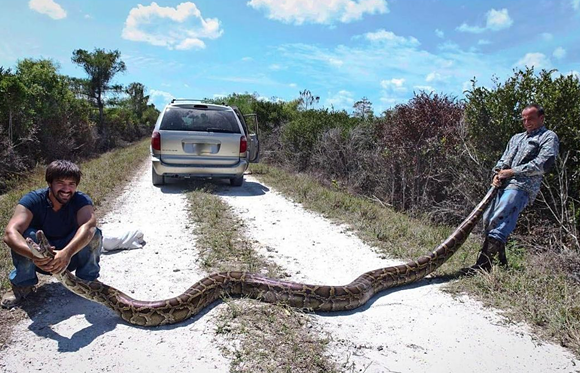“Adam blamed Eve. Eve blamed the poor snake and the snake didn’t have a leg to stand On.”
Here is a photo of Jason and I bonding with a 200 pound tame reticulated Burmese Python in Caron, Thailand that accompanied a feature story in the Saratoga News in April 2004 entitled A Quest for Life: "Father and Son Find Adventures and Enlightenment.” The thrill of interacting with such a beautiful bigger-than-life reptile is hard to describe. It’s constricting body felt like a living garland around our necks and shoulders that was tighter than the tuxedo I wore at my daughter Michelle’s and Kyle’s wedding. We were told it had recently ended it’s three week fast, and we prayed he wasn’t hungry.🙂 Who knew that 20 years later the Florida authorities would be placing a bounty on the corpses of these exotic reptiles.
It’s not uncommon for Burmese pythons to attain lengths up to 23 feet and exceeding 175 pounds and to live up to 40 years. They inhabit the jungles and lush grassy marshes of Southeast Asia. They have sharp teeth and strong constricting muscles they use to kill their prey. They have become popular pets over the years due to their painted skin and generally docile disposition. They can be obtained at pet shops or breeder expos. Unfortunately, they often wind up in the hands of negligent and incompetent owners. Due to the abhorent illicit trafficking trade, they have established themselves in warm states like Florida, far from their native land.
Though giant pythons have been involved in less than 10 fatal deaths in the past decade, (rate is higher for human deaths involving horses and dogs), these deaths are preventable. When handling or feeding a python, it must be contained in a safe enclosure. Some years back, a 19 year old man from the Bronx was found dead in his apartment. Apparently, his 11-foot Burmese python entwined around his body. The police believed that the pet python mistook the pet owner for food when he was getting ready to feed his python a chicken. Once a python gets around the upper body, a person can become unconcious in minutes, as the carotid artery gets cut off if a person panics.
Through no fault of there own, these pythons have been smuggled into the South Florida by traffickers over the years and in the process have created a reptilian nightmare for the ecosystem. Pythons have taken up residence in the Everglades National Park. Their prey: rabbits, foxes, deer, bobcats, opossums and raccoons, which are close to being wiped out. Pythons are great swimmers and can stay submerged under water for 30 minutes before coming up for air.
Trafficking of exotic Burmese pythons has been going on since the 1970s. Naive pet owners, no longer able to deal with these creatures as they grew to full size, began dumping them in the Everglades. The National Park Service estimates that over 100,000 pythons are in the swamps of South Florida due to their breeding and multiplying. It has become a public menace. According to Michale E. Dorcas, a herpetologist at Davidson College in North Carolina, “there hasn’t been a snake big enough to eat a raccoon in Florida for about 18 million years."
It’s become such a problem that Florida authorities have resorted to hiring bounty hunters in a program called “Python Challenge," but it has barely made a dent in decreasing the python population. According to Wikipedia, the problem is so serious that Florida has placed restrictions on keeping them as pets. Violators face imprisonment for more than 7 years or fined $500,000.
*Quote Source: Michael E. Dorcas, a herpetologist at Davidson College in North Carolina, said in a 2012 interview with Yale Environment 360, an online publication of the Yale School of Forestry and Environmental Studies
*Photo Credit: of bounty hunters, Nicholas Banos/Facebook

